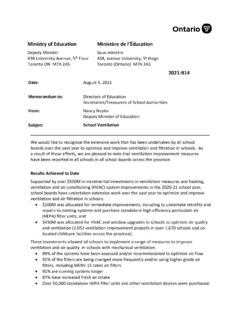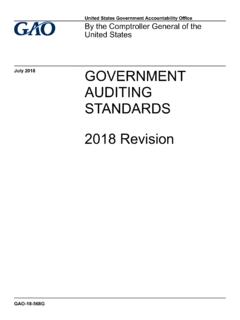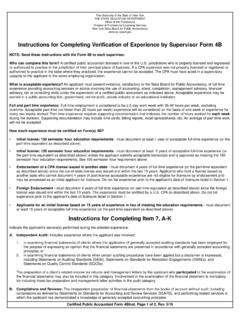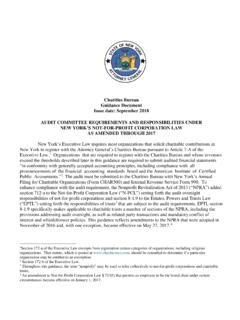Transcription of ILLUSTRATIVE NOTES DISCLOSURES TO THE CONSOLIDATED ...
1 1 ILLUSTRATIVE NOTES DISCLOSURES TO THE CONSOLIDATED FINANCIAL STATEMENTS (Revised September 2012) These ILLUSTRATIVE NOTES are a sample of what the Board may wish to disclose. They are provided to aid the sector in the preparation of the financial statements. The content of the NOTES is the responsibility of the Board, and may be different than shown below. Boards should prepare the NOTES and consult with their auditors as appropriate MANAGEMENT REPORT .. 2 INDEPENDENT AUDITOR S REPORT .. 3 1. SIGNIFICANT ACCOUNTING POLICIES .. 5 a) Basis of Accounting .. 5 b) Reporting Entity .. 6 c) Trust Funds .. 7 d) Cash and Cash Equivalents .. 7 e) Investments .. 7 f) Deferred Revenue .. 7 g) Deferred Capital Contributions .. 7 h) Retirement and Other Employee Future Benefits .. 8 i) Tangible Capital Assets .. 9 j) Government Transfers .. 10 k) Investment Income .. 10 l) Long-term Debt (if applicable) .. 10 m) Budget Figures .. 10 n) Use of Estimates .. 10 2. INVESTMENTS .. 11 3.
2 ACCOUNTS RECEIVABLE - GOVERNMENT OF ONTARIO .. 11 4. ASSETS HELD FOR SALE .. 11 5. DEFERRED REVENUE .. 12 6. DEFERRED CAPITAL CONTRIBUTIONS .. 13 7. RETIREMENT AND OTHER EMPLOYEE FUTURE BENEFITS .. 14 8. NET LONG TERM DEBT .. 19 9. TEMPORARY BORROWING .. 20 10. DEBT CHARGES AND CAPITAL LOANS AND LEASES INTEREST .. 20 11. EXPENSES BY OBJECT .. 21 12. BOARD PERFORMS DUTIES OF A MUNICIPAL COUNCIL .. 21 13. TANGIBLE CAPITAL ASSETS .. 22 14. ACCUMULATED SURPLUS .. 23 15. TRUST FUNDS .. 23 16. ONTARIO SCHOOL BOARD INSURANCE EXCHANGE (OSBIE) .. 23 17. CONTRACTUAL OBLIGATIONS AND CONTINGENT LIABILITIES .. 24 18. SEGMENTED INFORMATION (if applicable) .. 24 19. PARTNERSHIP IN [NAME] TRANSPORTATION CONSORTIUM .. 24 20. REPAYMENT OF 55 SCHOOL BOARD TRUST FUNDING .. 26 21. SUBSEQUENT EVENT .. 26 2 MANAGEMENT REPORT [This is a sample management report only. Auditor may modify based on individual board s circumstances.] Management s Responsibility for the CONSOLIDATED Financial Statements The accompanying CONSOLIDATED financial statements of the.
3 Board are the responsibility of the Board management and have been prepared in accordance with the Financial Administration Act, supplemented by Ontario Ministry of Education memorandum 2004:B2 and Ontario Regulation 395/11 of the Financial Administration Act, as described in Note 1 to the CONSOLIDATED financial statements. (except for ..any qualification per auditors ). The preparation of CONSOLIDATED financial statements necessarily involves the use of estimates based on management s judgement, particularly when transactions affecting the current accounting period cannot be finalized with certainty until future periods. Board management maintains a system of internal controls designed to provide reasonable assurance that assets are safeguarded, transactions are properly authorized and recorded in compliance with legislative and regulatory requirements, and reliable financial information is available on a timely basis for preparation of the CONSOLIDATED financial statements.
4 These systems are monitored and evaluated by management. The Board meets with management and the external auditors to review the CONSOLIDATED financial statements and discuss any significant financial reporting or internal control matters prior to their approval of the CONSOLIDATED financial statements. The CONSOLIDATED financial statements have been audited by .., independent external auditors appointed by the Board. The accompanying Independent Auditors Report outlines their responsibilities, the scope of their examination and their opinion on the Board s CONSOLIDATED financial statements. _____ _____ Director of Education Chief Financial Officer November xx, 2012 (Same date as Auditors Report) 3 INDEPENDENT AUDITOR S REPORT [This is a sample auditor s report only. Auditor may modify based on individual board s circumstances such as when there is a qualification in the opinion or when the prior year figures are not audited.]
5 ] To the Board of Trustees of the XX District School Board We have audited the accompanying CONSOLIDATED financial statements of XX District School Board, which comprise the CONSOLIDATED statements of financial position as at August 31, 2012 and August 31, 2011, the CONSOLIDATED statements of operations, changes in net debt and cash flows for the years then ended and a summary of significant accounting policies and other explanatory information. Management s Responsibility for the CONSOLIDATED Financial Statements Management is responsible for the preparation of these CONSOLIDATED financial statements in accordance with the basis of accounting described in Note 1 to the CONSOLIDATED financial statements, and for such internal control as management determines is necessary to enable the preparation of CONSOLIDATED financial statements that are free from material misstatement, whether due to fraud or error. Auditors Responsibility Our responsibility is to express an opinion on these CONSOLIDATED financial statements based on our audits.
6 We conducted our audits in accordance with Canadian generally accepted auditing standards . Those standards require that we comply with ethical requirements and plan and perform the audit to obtain reasonable assurance about whether the CONSOLIDATED financial statements are free from material misstatement. An audit involves performing procedures to obtain audit evidence about the amounts and DISCLOSURES in the CONSOLIDATED financial statements. The procedures selected depend on our judgment, including the assessment of the risks of material misstatement of the CONSOLIDATED financial statements, whether due to fraud or error. In making those risk assessments, we consider internal control relevant to the entity s preparation of the CONSOLIDATED financial statements in order to design audit procedures that are appropriate in the circumstances, but not for the purpose of expressing an opinion on the effectiveness of the entity s internal control.
7 An audit also includes evaluating the appropriateness of accounting policies used and the reasonableness of accounting estimates made by management, as well as evaluating the overall presentation of the CONSOLIDATED financial statements. We believe that the audit evidence we have obtained in our audits is sufficient and appropriate to provide a basis for our audit opinion. 4 Opinion In our opinion, the CONSOLIDATED financial statements of XX District School Board as at and for the years ended August 31, 2012 and August 31, 2011 are prepared, in all material respects, in accordance with the basis of accounting described in Note 1 to the CONSOLIDATED financial statements. Emphasis of Matter Without modifying our opinion, we draw attention to Note 1 to the CONSOLIDATED financial statements which describes the basis of accounting used in the preparation of these CONSOLIDATED financial statements and the significant differences between such basis of accounting and Canadian public sector accounting standards .
8 [Auditor's signature] [Date of the auditor's report] City, Canada 5 ILLUSTRATIVE EXAMPLES OF NOTES TO THE CONSOLIDATED FINANCIAL STATEMENTS For the year ended August 31, 2012 1. SIGNIFICANT ACCOUNTING POLICIES The CONSOLIDATED financial statements are prepared by management in accordance with the basis of accounting described below. a) Basis of Accounting The CONSOLIDATED financial statements have been prepared in accordance with the Financial Administration Act supplemented by Ontario Ministry of Education memorandum 2004:B2 and Ontario Regulation 395/11 of the Financial Administration Act. The Financial Administration Act requires that the CONSOLIDATED financial statements be prepared in accordance with the accounting principles determined by the relevant Ministry of the Province of Ontario. A directive was provided by the Ontario Ministry of Education within memorandum 2004:B2 requiring school boards to adopt Canadian public sector accounting standards commencing with their year ended August 31, 2004 and that changes may be required to the application of these standards as a result of regulation.
9 In 2011, the government passed Ontario Regulation 395/11 of the Financial Administration Act. The Regulation requires that contributions received or receivable for the acquisition or development of depreciable tangible capital assets and contributions of depreciable tangible capital assets for use in providing services, be recorded as deferred capital contributions and be recognized as revenue in the statement of operations over the periods during which the asset is used to provide service at the same rate that amortization is recognized in respect of the related asset. The regulation further requires that if the net book value of the depreciable tangible capital asset is reduced for any reason other than depreciation, a proportionate reduction of the deferred capital contribution along with a proportionate increase in the revenue be For Ontario school boards, these contributions include government transfers, externally restricted contributions and, historically, property tax revenue.
10 The accounting policy requirements under Regulation 395/11 are significantly different from the requirements of Canadian public sector accounting standards which requires that government transfers, which do not contain a stipulation that creates a liability, be recognized as revenue by the recipient when approved by the transferor and the eligibility criteria have been met in accordance with public sector accounting standard PS3410; 6 externally restricted contributions be recognized as revenue in the period in which the resources are used for the purpose or purposes specified in accordance with public sector accounting standard PS3100; and property taxation revenue be reported as revenue when received or receivable in accordance with public sector accounting standard PS3510. As a result, revenue recognized in the statement of operations and certain related deferred revenues and deferred capital contributions would be recorded differently under Canadian Public Sector Accounting standards .











